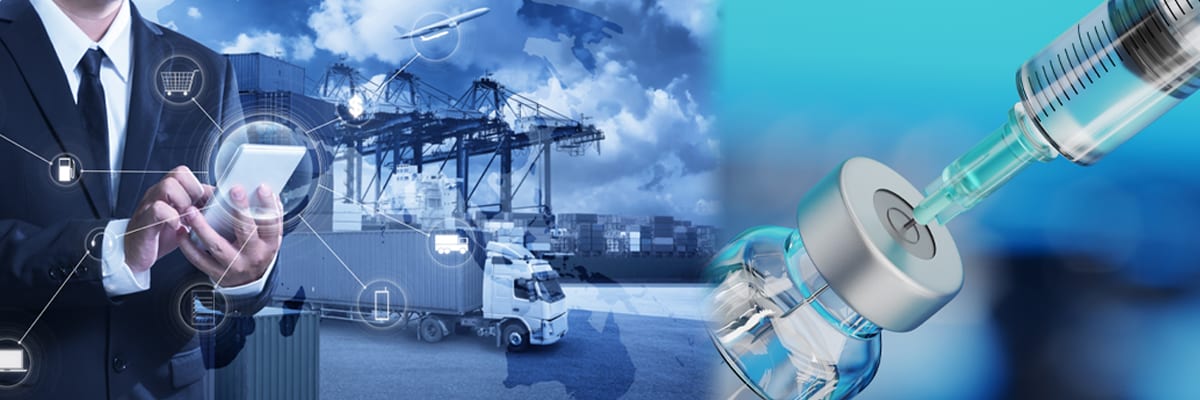The Ultimate Guide to Pharmaceutical Transport
Best Practices for Temperature-Controlled Transportation of Pharmaceutical Products Throughout the Cold Chain

The safe and secure transportation of pharmaceutical products is essential to ensure that patients receive the medications they need to manage their health. However, transporting pharmaceutical products is a complex process that requires careful planning, temperature monitoring, specialized packaging, and adherence to regulatory requirements.
In this ultimate guide to pharmaceutical transport, we will provide an in-depth overview of the various aspects involved in transporting pharmaceutical products, including an overview of shipping regulations, the steps involved in transporting pharmaceuticals, common challenges, best practices, and more.
By following this guide, shippers can support the safe and secure transportation of their pharmaceutical products, while also complying with regulatory requirements and mitigating risk.
An Overview of Pharmaceutical Transport
Pharmaceutical transport refers to the movement of drugs, medications, vaccines, and other pharmaceutical products from one location to another. This can include transport across local, national, and international borders.
Pharmaceutical transport is critical to ensure that drugs and medical supplies are available to patients when and where they are needed. However, transporting pharmaceutical products is not a simple process, and it involves careful consideration of various factors, including temperature control, product handling, and packaging.
One critical factor in pharmaceutical transport is the type of medicines that are being shipped. There are several types of medicines that may be shipped, including ambient, cryogenic, and refrigerated.
Ambient medicines
Medicines that can be transported at room temperature, typically between 15°C and 25°C. Examples of ambient medicines include tablets, capsules, and powders.
Cryogenic medicines
Medicines that require extremely cold temperatures to maintain their stability, typically below -150°C. These products may include vaccines, blood products, and tissue samples.
Refrigerated medicines
Medicines that require cooling during transport, typically between 2°C and 8°C. Examples of refrigerated medicines include insulin, some vaccines, and biologic drugs.
Understanding the different types of medicines and their temperature requirements is crucial to ensure their safe and effective transport.
An Overview of Shipping Regulations for Pharma
Shipping pharmaceutical products involves complying with a complex set of regulations to ensure that products are transported safely, securely, and efficiently. The regulations vary by country, region, and mode of transport. Here, we provide an overview of the main regulations governing the shipment of pharmaceutical products.
Good Distribution Practices (GDP)
Good Distribution Practices (GDP) are a set of guidelines established by the World Health Organization (WHO) to ensure that pharmaceutical products are transported and stored in a manner that maintains their quality, safety, and efficacy. GDP covers all aspects of the supply chain, including storage, transport, and distribution.
Code of Federal Regulations (CFR)
In the United States, the Code of Federal Regulations (CFR) provides guidance on the transport of pharmaceutical products. The CFR covers all aspects of the transport of pharmaceuticals, including labeling, packaging, and documentation.
European Union (EU) Regulations (EU GDP)
In the European Union (EU), the transport of pharmaceutical products is governed by the Good Distribution Practice (GDP) guidelines. These guidelines cover all aspects of the supply chain, including transport, storage, and distribution. Additionally, the EU has established regulations governing the transport of dangerous goods, including pharmaceuticals.
International Air Transport Association (IATA) Regulations
The International Air Transport Association (IATA) has established regulations governing the transport of dangerous goods, including pharmaceutical products. These regulations provide guidance on how to pack, mark, and label shipments of dangerous goods, including pharmaceuticals.
International Maritime Dangerous Goods (IMDG) Regulations
The International Maritime Dangerous Goods (IMDG) regulations govern the transport of dangerous goods by sea, including pharmaceutical products. The regulations provide guidance on the safe transport of dangerous goods, including the packing, marking, and labeling of shipments.
Many other countries have additional regulations that are variations of those mentioned above. Understanding and complying with these regulations is essential to ensure the safe and efficient transport of pharmaceutical products.
Three Steps of Transporting Pharmaceuticals
Transporting pharmaceutical products involves several steps, including supply, transportation, and storage. In this section, we will outline these steps in more detail.
Supply
The first step in transporting pharmaceutical products is to ensure a reliable supply chain. This involves selecting suppliers and manufacturers who can provide high-quality products that meet the required specifications. The supply chain must also be designed to minimize the risk of product degradation or contamination during transport.
Transportation
The transportation step involves moving the pharmaceutical products from one location to another. This may involve several modes of transport, including air, sea, or land. It is essential to select the appropriate mode of transport that meets the requirements of the product being shipped. During transportation, the products must be properly packed, marked, and labeled to ensure they are transported safely and securely. Selecting the right logistics and freight forwarders with expertise in handling pharmaceutical products and providing the appropriate level of service for the mode of transport and route being used is crucial for ensuring safe and secure transportation while complying with regulations.
Storage
The final step in transporting pharmaceutical products is storage. Proper storage is crucial to maintain the quality, safety, and efficacy of the products. The storage conditions must meet the specific requirements of the product being transported, such as temperature control, humidity control, and protection from light. It is also essential to monitor the storage conditions to ensure they remain within the required range, which is based on the label claim for a particular drug. Storage temperatures are crucial even during transit, as products will often be stored temporarily at waypoints during their journeys.
Transporting pharmaceutical products involves several critical steps, each of which must be carefully planned and executed to ensure the products are transported safely and securely. In the next sections of this guide, we will provide more detailed information on the specific challenges and solutions involved in each step of the process.
Challenges when Shipping Medicine
Shipping pharmaceutical products comes with several challenges that can arise throughout the supply chain. These challenges can range from supply chain disruptions to ensuring the integrity of temperature-sensitive drugs during transport. In this section, we will discuss some of the key challenges that arise when shipping medicine.
Supply Chain Disruptions
The pharmaceutical industry is subject to a wide range of supply chain disruptions, including raw material shortages, manufacturing delays, and transportation issues. These disruptions can lead to delays, increased costs, and product shortages. To overcome these challenges, it is essential to have a robust supply chain management system in place that can quickly adapt to changes in the supply chain. Leveraging real-time visibility can also alert shippers to disruptions as they happen, enabling risk mitigation actions.
Shipping Temperature-Sensitive Drugs
Many pharmaceutical products, such as vaccines and biologics, are temperature-sensitive and require strict temperature control during transport. Failure to maintain the required temperature range can result in product degradation, reduced efficacy, or even patient harm. Ensuring proper temperature control during transport may require the use of specialized packaging and temperature monitoring solutions.
Regulatory Compliance
As discussed earlier in this guide, shipping pharmaceutical products is subject to a complex set of regulations. Failing to comply with these regulations can result in penalties, fines, and damage to the reputation of the company. Compliance requires extensive testing, documentation, training, and monitoring throughout the supply chain.
What are Good Practices for Transporting Pharmaceuticals?
Transporting pharmaceutical products requires adherence to good practices to ensure that the products are transported safely and securely. In this section, we will discuss some of the best practices for transporting pharmaceuticals.
Monitor In-Transit Temperatures
Temperature monitoring devices, or dataloggers, record temperatures at regular intervals during transportation. On arrival at the product’s destination, an indicator will tell receivers whether the shipment went out of its temperature range, and a detailed, regulatory compliant record can be retrieved from the device for use in quality product release and documentation. Temperature monitoring demonstrates that a pharmaceutical product is safe and efficacious, while also ensuring regulatory compliance.
Leverage Real-Time Visibility
Real-time visibility is becoming increasingly critical for ensuring that pharmaceutical products are transported safely and securely. These types of solutions use tracking devices and cloud-based dashboards that provide real-time data and insights into the location, condition, and security of the products during transport. By leveraging real-time visibility, shippers can quickly identify and address any issues that arise during transport, such as temperature excursions or logistics delays.
Document the Entire Process
Documenting the entire process of transporting pharmaceutical products is critical to ensure compliance with regulatory requirements and to provide an audit trail to prove one is in control of the proper shipping process. This documentation should include records of the temperature conditions during transport, as well as any deviations from the required conditions. It should also include records of the packaging, labeling, and marking of the products during transport.
Use Specialized Packaging
Using specialized packaging is essential to ensure that temperature-sensitive pharmaceutical products are transported safely and securely. This may include using insulated containers, thermal blankets, and phase-change materials to maintain the required temperature range during transport. It is also essential to ensure that the packaging is properly labeled and marked to indicate the temperature requirements and any handling instructions.
Train Personnel
Training personnel involved in transporting pharmaceutical products is critical to ensure that they understand the requirements and best practices for transport. This includes training on proper handling procedures, documentation requirements, and the use of temperature monitoring solutions. Regular training and refresher courses can help ensure that personnel remain up to date on the latest best practices and regulatory requirements.
By following these best practices, shippers can ensure that pharmaceutical products are transported safely and securely. At Sensitech, we provide comprehensive solutions to help our customers adhere to these best practices, including global real-time visibility solutions, passive temperature monitoring, and training and consulting services.
Final Thoughts
Transporting pharmaceutical products is a complex process that requires careful planning, specialized packaging, and compliant, accurate temperature monitoring. At Sensitech, we understand the challenges associated with the transport and cold chain monitoring of pharmaceutical products and offer comprehensive solutions to help our customers ship with confidence and peace of mind.
Our temperature monitoring solutions help assure that temperature-sensitive drugs are transported safely and securely, while our supply chain visibility solutions provide real-time data and insights to help customers identify and mitigate potential disruptions in the supply chain. We also offer cost-effective training and consulting services to help customers navigate the complex regulatory landscape.
By partnering with Sensitech, life sciences companies can ensure that their pharmaceutical shipments comply with regulatory requirements and mitigate risk. We invite you to get in touch with our team to learn more about how we can help you optimize and grow your pharmaceutical transport operations. Contact Us today to speak with one of our experts and start shipping with confidence.

